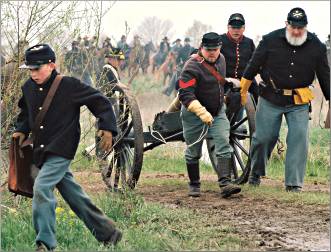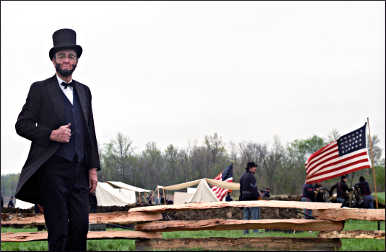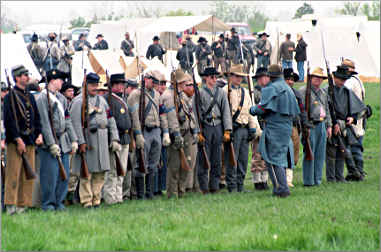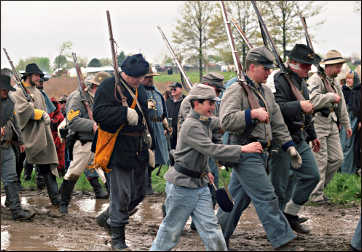Missouri's memories
After 150 years, the Civil War still haunts the western part of the state, long terrorized by jayhawkers and bushwackers.

© Beth Gauper
In April 1861, the first shots of the Civil War were fired at Fort Sumter in South Carolina.
The most famous battles that followed-Bull Run, Antietam, Gettysburg, Shiloh — were in the East.
But after Virginia and Tennessee, the most fought-over state was Missouri, which suffered 45 percent of all casualties.
Today, there's still bad blood. At battle reenactments less than four hours from Des Moines, audiences mutter about Yankee dogs and greet Union reenactors with stone faces.
To a Northerner, it's eye-opening. But perhaps more than any other state, Missouri was scarred by the Civil War — or War Between the States, as many call it.
During the sesquicentennial, along with the rest of the nation, Missouri is reliving the trauma.
The war in Missouri started just eight days after Fort Sumter, when Confederate forces seized the arsenal in Liberty, near Kansas City.
Skirmishes along its western border began six years before, as Kansas abolitionists led by John Brown clashed with slave-owning tobacco and hemp growers who had come from the South.
The first land battle of the war was fought in July 1861 in Carthage, a Confederate victory followed by two more in the state.
The Union regained control of Missouri at the Battle of Pea Ridge in March 1862, but bloody strife continued between Confederate guerrillas and Union garrison troops.
To take a side was to invite revenge, but those who tried to stay neutral were preyed upon by both sides.
Eventually, people simply fled. Jasper County, where the Battle of Carthage was fought 16 days before the First Battle of Bull Run in Manassas, Va., had 6,383 residents in 1860. By war's end, only 30 remained.
"This area was so devastated," says Ed Robertson, a volunteer at the Museum of Pioneer History in Bates County, one of 3½ counties evacuated in 1863 under the notorious Order 11. "People were too appalled for years to talk about it. It was a taboo subject for a long time."
In some parts of western Missouri, resentment is passed down like an heirloom. The mother of Harry Truman, born in nearby Lamar, wouldn't sleep in the Lincoln Room after her son became president. Even today, at battle re-enactments, Rebels leave the field to warm applause.

© Beth Gauper
"There are some very strong Southern sympathies in this county," Robertson said. "There are still areas where they talk about the Yankee dogs."
In western Missouri, the personal became political. It was hard to look at abstract issues of justice and equality when your brother had been killed by Jayhawkers from Kansas, or your house and crops confiscated by German-speaking troops from St. Louis.
Residents of the area had come from the South, so their sympathies lay there, but they became more extreme after brutal incursions by Kansas military units.
"(Their) conduct . . . has done more for the enemy in this state than could have been accomplished by 20,000 of his own army," wrote Maj. Gen. Henry Halleck to the U.S. Army commander-in-chief in December 1861.
Homegrown guerrillas
That's about when the infamous William Quantrill began his career. Three months later, Halleck issued an order requiring guerrillas to be executed upon capture. It didn't stop Quantrill, whose band of bushwhackers, including Frank James and Cole Younger, terrorized Missouri for the rest of the war.
Many of the band, unable or unwilling to resume normal lives after the war — the 17-year-old Jesse James was shot in the leg while trying to surrender in Lexington — carried vengeance beyond it.
Hatred for Union Gen. Benjamin Butler, nicknamed "Spoons" because he liked to filch Confederate silver, may have drawn the James-Younger Gang to Northfield, Minn., in 1876.
Butler had $40,000 invested in the First National Bank, where his son-in-law, a former carpet-bagging governor of Mississippi, was a director.
"There was a lot of hatred to get through after the war," says Terry Ramsey, coordinator of the Bushwhacker Museum in Nevada.
Nevada was dubbed "Bushwhacker Capital of the World" by Union troops just before they burned it to the ground. Unable to catch the bushwhackers, Union troops simply destroyed crops, houses and anything else that could help them.
To northerners, who think of the Civil War in terms of good and evil, Missouri is an eye-opener.
"I always say, 'Keep your mouth shut and your eyes open,' " says Minnesota historian Newell Chester, who has led tours of Civil War sites in Missouri and other states.
"In Mississippi, you know what you're getting into. In Gettysburg, you know what you're getting into. But in Missouri, even with a scorecard, you can't tell what side the players are on."

© Beth Gauper
The biggest battles
Renactments will be held near the sites of all three of the main battles in western Missouri.
In Carthage , the first land battle of the war was fought in July 1861, when a well-trained force of 1,100 German immigrants from St. Louis, led by Col. Franz Sigel, clashed with the 6,000-strong Missouri State Guard, led by pro-Southern governor Claiborne Jackson, who had been driven from the Capitol.
House-to-house fighting presaged the devastation to be wrought on civilians. It ended with a Union retreat, though Sigel lost only 13 soldiers to Jackson's 30.
Carthage was burned by bushwhackers in 1864. But it rebounded after the war, thanks to its stone quarries and lead and zinc mines, and today its streets are lined with lovely Victorian homes.
It once was a stop on Route 66, still marked by the Boots Motel and Route 66 Drive Inn. Downtown, the castlelike 1895 Jasper County Courthouse dominates a square lined with shops and cafes.
The Civil War Museum is nearby; it's a fine museum that tells the story with a mural, diorama, video and exhibits. It also tells of Myra Maebelle Shirley, an innkeeper's daughter who is said to have nursed soldiers at that first battle.
Later, she was a Confederate courier and intimate of Cole Younger and other guerrillas, and became known as Belle Starr, "Outlaw Queen."
The next big battle site is an hour east, near Springfield. Here, in August 1861, Brig. Gen. Nathaniel Lyon and Col. Sigel and 5,400 soldiers attacked 12,000 men under Gen. Ben Culloch and Maj. Gen. Sterling Price at Wilson's Creek .

© Torsten Muller
After six hours of fighting, Lyon's death and 1,317 casualties — 1,222 for the Confederates — the Federals withdrew.
One of the Rebel soldiers was Frank James; he was captured that winter, forced to pledge allegiance to the Union and released, after which he joined Quantrill's bushwhackers.
Today, the site is Wilson's Creek National Battlefield, which includes a visitors center, a five-mile auto tour and an evocative ¾-mile walking tour of Bloody Hill.
Price next headed for the prosperous Missouri River town of Lexington , not far from Kansas City. Riding into town, he laid siege to 2,700 Union occupiers, fortified in the grounds of Masonic College.
As the garrison ran out of water, Price's army of 10,000 advanced behind dense bales of water-soaked hemp, which repelled cannon balls.
The garrison surrendered, and Price became a hero throughout the South and in Lexington, returning all but $37,000 of the $960,000 the Federals had taken from the State Bank of Lexington.
Today, the Battle of Lexington State Historic Site includes the 1853 Anderson House, 100 acres of battlefield and a visitors center with exhibits that open a fascinating window into prewar Lexington.

© Beth Gauper
Slavery in the north
This town, unlike its counterparts in the southwest border counties, had a real stake in slavery: In Lafayette County, 47 percent of the population were slaves, many used to produce hemp, a time-intensive cash crop that withered after the war.
Old newspaper notices tell of slave auctions; a video with readings from a local white woman's diary speaks of the "exalted ideals" and "gracious way of life" shattered by the conflict.
Lexington was again occupied by Federals two weeks after the battle. The next spring, in March 1862, the Union won a decisive victory at the Battle of Pea Ridge, not far from Carthage in northwest Arkansas, and the Confederacy took its regular troops east.
But for the average Missourian, the war was far from over.
Trip Tips: Civil War in Missouri
During the sesquicentennial in Missouri, many towns and historic sites will reenact battles.
Camp Jackson: The Tipping Point in St. Louis. The encampment in Jefferson Barracks County Park reenact the May 1861 incidents that tipped Missouri into the Civil War. There will be music, vignettes, a reenactment of the capture of Camp Jackson Saturday and a general battle reenactment Sunday.
Battle of Carthage, a reenactment of the July 5, 1861, battle, the first major land battle of the Civil War, with 1,200 re-enactors. In the town of Carthage, in the southwest corner of the state.
Battle of Boonville . This town on the Missouri River and Katy Trail, in north-central Missouri, is reenacting the 1861 battle on its original site.
Battle of Wilson's Creek near Springfield. This "maximum effort" reenactment features 6,000 to 8,000 re-enactors at Wilson's Creek National Battlefield in southwest Missouri.
Battle of Lexington at the Battle of Lexington State Historic Site , with 1,200 re-enactors. In the town of Lexington, just east of Kansas City.
Battle of Westport : In September 1864, Maj. Gen. Price returned to Missouri and was defeated the next month at the Battle of Westport (now Kansas City), the largest battle fought west of the Mississippi. A 32-mile self-guided auto tour around Kansas City includes 25 historical markers.
In June, the town of Nevada holds Bushwhacker Days. There's music, carnival rides and games, plus a 6:05 p.m. Saturday parade and historical reenactments. The Bushwhacker Museum, in an 1860 jail, is open Tuesday-Saturday from May through October.
More on historical sites : The site The Civil War in Missouri includes details on events and sites near St. Louis.
Visit Missouri includes pages on historical sites in the northwest, northeast, central, southeast and southwest parts of the state.
Tourism information : Visit Missouri, 800-519-2100.